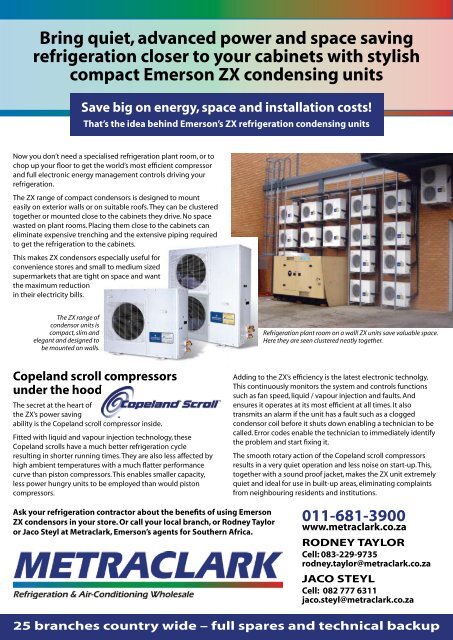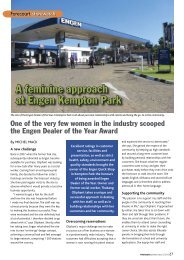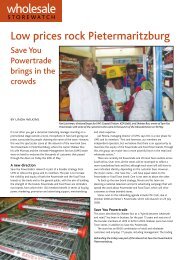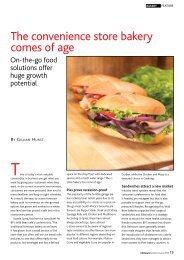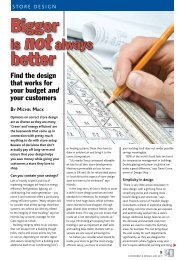Refrigeration - Supermarket.co.za
Refrigeration - Supermarket.co.za
Refrigeration - Supermarket.co.za
You also want an ePaper? Increase the reach of your titles
YUMPU automatically turns print PDFs into web optimized ePapers that Google loves.
Bring quiet, advanced power and space saving<br />
refrigeration closer to your cabinets with stylish<br />
<strong>co</strong>mpact Emerson ZX <strong>co</strong>ndensing units<br />
Save big on energy, space and installation <strong>co</strong>sts!<br />
That’s the idea behind Emerson’s ZX refrigeration <strong>co</strong>ndensing units<br />
Now you don’t need a specialised refrigeration plant room, or to<br />
chop up your floor to get the world’s most efficient <strong>co</strong>mpressor<br />
and full electronic energy management <strong>co</strong>ntrols driving your<br />
refrigeration.<br />
The ZX range of <strong>co</strong>mpact <strong>co</strong>ndensors is designed to mount<br />
easily on exterior walls or on suitable roofs. They can be clustered<br />
together or mounted close to the cabinets they drive. No space<br />
wasted on plant rooms. Placing them close to the cabinets can<br />
eliminate expensive trenching and the extensive piping required<br />
to get the refrigeration to the cabinets.<br />
This makes ZX <strong>co</strong>ndensors especially useful for<br />
<strong>co</strong>nvenience stores and small to medium sized<br />
supermarkets that are tight on space and want<br />
the maximum reduction<br />
in their electricity bills.<br />
The ZX range of<br />
<strong>co</strong>ndensor units is<br />
<strong>co</strong>mpact, slim and<br />
elegant and designed to<br />
be mounted on walls.<br />
<strong>Refrigeration</strong> plant room on a wall! ZX units save valuable space.<br />
Here they are seen clustered neatly together.<br />
Copeland scroll <strong>co</strong>mpressors<br />
under the hood<br />
The secret at the heart of<br />
the ZX’s power saving<br />
ability is the Copeland scroll <strong>co</strong>mpressor inside.<br />
Fitted with liquid and vapour injection technology, these<br />
Copeland scrolls have a much better refrigeration cycle<br />
resulting in shorter running times. They are also less affected by<br />
high ambient temperatures with a much flatter performance<br />
curve than piston <strong>co</strong>mpressors. This enables smaller capacity,<br />
less power hungry units to be employed than would piston<br />
<strong>co</strong>mpressors.<br />
Adding to the ZX’s efficiency is the latest electronic technolgy.<br />
This <strong>co</strong>ntinuously monitors the system and <strong>co</strong>ntrols functions<br />
such as fan speed, liquid / vapour injection and faults. And<br />
ensures it operates at its most efficient at all times. It also<br />
transmits an alarm if the unit has a fault such as a clogged<br />
<strong>co</strong>ndensor <strong>co</strong>il before it shuts down enabling a technician to be<br />
called. Error <strong>co</strong>des enable the technician to immediately identify<br />
the problem and start fixing it.<br />
The smooth rotary action of the Copeland scroll <strong>co</strong>mpressors<br />
results in a very quiet operation and less noise on start-up. This,<br />
together with a sound proof jacket, makes the ZX unit extremely<br />
quiet and ideal for use in built-up areas, eliminating <strong>co</strong>mplaints<br />
from neighbouring residents and institutions.<br />
Ask your refrigeration <strong>co</strong>ntractor about the benefits of using Emerson<br />
ZX <strong>co</strong>ndensors in your store. Or call your local branch, or Rodney Taylor<br />
or Ja<strong>co</strong> Steyl at Metraclark, Emerson’s agents for Southern Africa.<br />
011-681-3900<br />
www.metraclark.<strong>co</strong>.<strong>za</strong><br />
Rodney Taylor<br />
Cell: 083-229-9735<br />
rodney.taylor@metraclark.<strong>co</strong>.<strong>za</strong><br />
Ja<strong>co</strong> Steyl<br />
Cell: 082 777 6311<br />
ja<strong>co</strong>.steyl@metraclark.<strong>co</strong>.<strong>za</strong><br />
25 branches <strong>co</strong>untry wide – full spares and technical backup
REFRIGERATION<br />
Save energy<br />
and reduce<br />
<strong>co</strong>sts before it’s<br />
too late<br />
By La u r a Du r h a m<br />
The <strong>co</strong>sts of running a store<br />
may seem to be spiralling out of<br />
<strong>co</strong>ntrol, what with staff regularly<br />
demanding higher wages, fuel<br />
and food increases and, of <strong>co</strong>urse,<br />
Eskom’s price hikes (set to rise<br />
again in July). Reducing energy<br />
<strong>co</strong>sts, particularly in refrigeration<br />
– the highest <strong>co</strong>ntribution to<br />
the bill – is no longer just a good<br />
idea, it’s vital for a store’s survival<br />
in an increasingly <strong>co</strong>mpetitive<br />
trading environment. <strong>Supermarket</strong><br />
& Retailer spoke to a number of<br />
experts about how retailers can<br />
start reducing their refrigeration<br />
<strong>co</strong>st today.<br />
<strong>Refrigeration</strong>:<br />
Don’t ignore<br />
the hidden<br />
<strong>co</strong>sts<br />
It’s time to cut <strong>co</strong>sts<br />
The tough e<strong>co</strong>nomic climate has forced<br />
many retail groups to re-evaluate the way<br />
they do business, with a particular focus on<br />
cutting <strong>co</strong>sts, especially when it <strong>co</strong>mes to<br />
electricity use. “However, many <strong>co</strong>mpanies<br />
make the mistake to think that once<br />
they’ve installed a solar geyser or switched<br />
to energy efficient light bulbs, they’ve<br />
done as much as they can,” says Asanda<br />
Makanda, MD of energy saving <strong>co</strong>nsultancy,<br />
MaNoa.<br />
But this <strong>co</strong>uldn’t be further from the<br />
truth – <strong>co</strong>nservative estimates show that<br />
most businesses are paying between 10%-<br />
30% too much for their electricity, money<br />
that’s literally being poured away when it<br />
<strong>co</strong>uld add to their bottom line,” she adds.<br />
There is a number of power saving<br />
interventions available on the market for<br />
retailers to <strong>co</strong>nsider. Most can be used<br />
in <strong>co</strong>njunction with existing equipment<br />
to improve efficiency and reduce energy<br />
demand, while others require some serious<br />
Capex. But while the initial capital outlay of<br />
these may seem daunting, the resulting<br />
savings and efficiencies are well worth it in<br />
the long run.<br />
Existing units<br />
One way to reduce energy <strong>co</strong>nsumption on<br />
an existing refrigeration unit is to introduce<br />
electronic <strong>co</strong>ntrol systems, says Rodney<br />
Taylor, marketing manager at Metraclark.<br />
This involves fitting electronic expansion<br />
valves to cabinets, rack <strong>co</strong>ntrollers to<br />
multiplex units and installing a monitoring<br />
unit or store <strong>co</strong>ntroller. Cost restrictions<br />
might mean that retailers have to make<br />
their current equipment more efficient,<br />
such as fitting an electronic <strong>co</strong>ntrol system<br />
but most new equipment <strong>co</strong>mes standard<br />
with such a system.<br />
An energy management system <strong>co</strong>uld<br />
save up to 20% of energy <strong>co</strong>sts, says Roy<br />
Singh, technical and development director<br />
at The Fridge Factory. This automatically<br />
monitors and adjusts the temperature<br />
a few hours after the door has not been<br />
opened to save electricity and the daymode<br />
temperature is re-activated when the<br />
door is opened. Additional benefits of the<br />
system include: shutting down the lights at<br />
night; slowing the speed of variable speed<br />
drive <strong>co</strong>mpressors when demand is low;<br />
optimising the defrost cycle duration and<br />
reducing the amount of heat required for<br />
defrost in the cycle.<br />
The life cycle of a refrigeration plant<br />
is based on quality of equipment,<br />
maintenance and proper use, “but if it is<br />
looked after properly, you <strong>co</strong>uld probably<br />
get 10 years out,” says Taylor. Of <strong>co</strong>urse,<br />
outside factors such as the moisture at the<br />
<strong>co</strong>ast that leads to rust, will also play a big<br />
part in the expected life cycle.<br />
▲<br />
9<br />
SUPERMARKET & RETAILER, MAY 2011
REFRIGERATION<br />
▲<br />
New equipment options<br />
■ Scroll <strong>co</strong>mpressor<br />
The latest <strong>co</strong>mpressor technology is the<br />
scroll <strong>co</strong>mpressor, which uses a different<br />
technology altogether. “This results in a<br />
much more efficient <strong>co</strong>mpression process,”<br />
explains Taylor.<br />
■ Variable speed fans and<br />
<strong>co</strong>mpressors<br />
You can also fit variable speed fans<br />
and variable speed <strong>co</strong>mpressors, which<br />
effectively matches capacity to demand.<br />
There is therefore no power surge from 0 to<br />
100% as in a stop-start process, resulting<br />
in huge power savings.<br />
■ Electronic expansion valves<br />
You should also fit electronic expansion<br />
valves, which provides greater efficiency<br />
than older types of thermostatic expansion<br />
valves. Electronic expansion valves react<br />
instantly and precisely to changes in<br />
cabinet demand for <strong>co</strong>oling.<br />
■ Floating suction pressure<br />
The suction pressure set point varies<br />
ac<strong>co</strong>rding to the demand from the<br />
refrigeration showcases. “The algorithm<br />
identifies the critical units that require<br />
higher performance from the <strong>co</strong>mpressor<br />
rack and <strong>co</strong>ntrol is adjusted ac<strong>co</strong>rdingly,”<br />
explains Maurice Robinson, sales manager<br />
at Carel Controls SA. In this way, the<br />
<strong>co</strong>mpressor rack <strong>co</strong>nsumes no more than<br />
necessary at any given time, <strong>co</strong>mpletely<br />
E<strong>co</strong>1_print_ad_S&Retailer_1 5/12/11 1:30 PM Page 1<br />
automatically.<br />
■ Anti-sweat heaters with selfadaptive<br />
algorithm<br />
The anti-sweat heaters are <strong>co</strong>ntrolled with<br />
a variable duty cycle. Output is carefully<br />
adjusted ac<strong>co</strong>rding to room temperature<br />
and humidity and the unit glass and frame<br />
temperature. In addition, says Robinson, a<br />
special algorithm is available to estimate<br />
the glass temperature and the dew point:<br />
this means heater operation can be<br />
adapted to current <strong>co</strong>nditions without<br />
having to install other probes on the<br />
refrigerated showcases.<br />
■ Multiplex plant<br />
Replacing a simplex, one cabinet / one<br />
<strong>co</strong>mpressor refrigeration plant with a<br />
multiplex plant is a no-brainer. With a<br />
multiplex plant, you are able to accurately<br />
C M Y CM MY CY CMY K<br />
match capacity to demand, and should one<br />
<strong>co</strong>mpressor be out of order, the cabinets<br />
can still rely on the rest of the <strong>co</strong>mpressors<br />
in the plant. The <strong>co</strong>st reduction in switching<br />
from simplex to multiplex would depend<br />
on the size of the plant.<br />
■ Skip defrost<br />
Unnecessary defrosts can be avoided<br />
based on the duration of previous defrosts.<br />
The duration of a defrost depends on the<br />
amount of ice formed on the <strong>co</strong>il, and<br />
based on the previous durations and other<br />
fine-tuning parameters, up to a maximum<br />
of three <strong>co</strong>nsecutive defrosts can be<br />
skipped.<br />
■ Night curtains<br />
Night curtains are placed on the refrigeration<br />
cabinets and the retailer pulls them<br />
Removable glass lids keep the temperature <strong>co</strong>nstant and ensure that<br />
the product quality is <strong>co</strong>nsistent because of minimal temperature changes.<br />
▲<br />
Composite<br />
10<br />
SUPERMARKET & RETAILER, MAY 2011
REFRIGERATION<br />
▲<br />
down or over the fridges at night in order<br />
to reduce the amount of energy the<br />
refrigeration needs to expend in order<br />
to keep the temperature at the required<br />
degree. If no <strong>co</strong>ld air is escaping, then the<br />
refrigeration unit doesn’t need excessive<br />
power wattage to keep operating.<br />
■ Digital scrolls<br />
Digital scrolls are an emerging technology<br />
in Europe (not in SA yet) that is far more<br />
efficient than any other <strong>co</strong>mpressor when<br />
using to match capacity and demand as<br />
there is no need to vary speed (which<br />
be<strong>co</strong>mes an issue of lubrication and<br />
vibration). The <strong>co</strong>mpressor runs at a<br />
<strong>co</strong>nstant speed and capacity is reduced by<br />
simply opening and closing the scroll set.<br />
Before, a variable speed drive was necessary<br />
– a <strong>co</strong>stly addition and a further source of<br />
possible inefficiency – but digital scrolls<br />
yields this unnecessary.<br />
■ EVI technology<br />
There are a number of energy saving<br />
initiatives taking place around pre-<strong>co</strong>oling<br />
either the <strong>co</strong>ndenser or the liquid line.<br />
Electronic Vapour Injection (EVI) pre-<strong>co</strong>ols<br />
the refrigerant before it goes into the<br />
cabinet, effectively gaining more capacity<br />
from the same cabinet. This greatly<br />
improves the Coefficient of Performance<br />
(COP) of the refrigeration plant. A <strong>co</strong>oler<br />
refrigerant has a much bigger <strong>co</strong>oling effect<br />
in the fridges and that means the fridges<br />
require less refrigerant to get the same<br />
<strong>co</strong>oling effect. Needing less refrigerant also<br />
means that smaller diameter pipes in the<br />
fridges are required – another <strong>co</strong>st saving.<br />
EVI technology enables a smaller capacity<br />
<strong>co</strong>mpressor to achieve the same result as<br />
a larger capacity <strong>co</strong>mpressor, due to the<br />
efficiency of the <strong>co</strong>mpression process.<br />
Traditionally, self-<strong>co</strong>ntained or plug-in cabinets were limited to smaller displays, such as ice<br />
cream at the check out. However, plug-ins are now a real option for regular cabinets in the rest of<br />
the store. Ultimately the decision is based on <strong>co</strong>st, capacity and efficiency.<br />
TRYING TO<br />
REDUCE<br />
YOUR STORES<br />
STOCK LOSS<br />
AND ENERGY<br />
COSTS?<br />
Freezers are responsible for the<br />
majority of your stores stock loss<br />
and energy <strong>co</strong>sts.<br />
Introducing a <strong>co</strong>st effective solution...<br />
sliding glass doors which can be installed<br />
onto EXISTING Fridges & Freezers.<br />
Falkberg<br />
Tel:<br />
• Minimal temperature loss<br />
– Frozen food is stored at re<strong>co</strong>mmended storage temperatures<br />
validating expiry dates<br />
– <strong>Refrigeration</strong> Plant runs for shorter periods with shorter defrost<br />
time, thus saving electricity<br />
• Upright Door System available for veg and meat display cabinets<br />
• Ultimately decreases stock loss and increases profits<br />
Glass Fridge Door Manufacturers for the Commercial <strong>Refrigeration</strong> Industry<br />
031 569 1146 • Cell: 083 488 4166 • Fax: 031 569 1145 • Fax: 086 680 1576<br />
email: falkberg@volt.<strong>co</strong>.<strong>za</strong><br />
www.pointedcircle.<strong>co</strong>.<strong>za</strong> (1134)
The power from the top (sealing to cabinet) with a flexible power pole allows the retailer to move<br />
the self-<strong>co</strong>ntained units at any time to a new location without having to open existing trenches<br />
in the floor to remove the drains and the <strong>co</strong>pper piping that is used to feed the gas to the cabinet<br />
from the outside plant room.<br />
“Switching to EVI does call for a slight<br />
increase in capital <strong>co</strong>st but this is offset by<br />
the reduction in the <strong>co</strong>st of <strong>co</strong>mpressors,”<br />
Taylor explains. EVI is not yet the standard<br />
modus operandi, but it is certainly gaining<br />
ground as people realise the benefits.<br />
Choosing the right refrigerant<br />
In a cascade system, one refrigeration<br />
system is used to <strong>co</strong>ol a se<strong>co</strong>nd system.<br />
This is useful when the se<strong>co</strong>nd system<br />
utilises a refrigerant that cannot operate<br />
under normal ambient <strong>co</strong>nditions. An<br />
example is the use of one system on R134a<br />
and the se<strong>co</strong>nd system on C02.<br />
The Fridge Factory’s Roy Singh says that<br />
when replacing units, hydrocarbon models<br />
should be substituted for the electricity<br />
guzzling HCFC refrigerators. “Hydrocarbon<br />
refrigerants can give electricity savings of<br />
up to 15%,” he says. Hydrocarbon<br />
refrigerants R290 or R600a are far more<br />
efficient than R124a and R404 because<br />
the refrigerant begins working at a lower<br />
temperature, so the <strong>co</strong>mponents do not<br />
have to work as long or as hard to achieve<br />
and maintain the required requirements.<br />
Additional benefits include reduced<br />
maintenance <strong>co</strong>sts – “as a direct result of<br />
the increased efficiency of the refrigerant,<br />
the <strong>co</strong>mpressor and other <strong>co</strong>mponents<br />
have an extended lifespan adding longterm<br />
<strong>co</strong>st savings on maintenance,”<br />
explains Singh. Also, less refrigerant is<br />
needed to do the same job, such as only<br />
needing 150g of hydrocarbon refrigerant<br />
as opposed to 420g of R137a in a<br />
standard 720l bottle <strong>co</strong>oler. Hydrocarbon<br />
refrigerants are also biodegradable.<br />
Cabinet and display decisions<br />
The fourth level of choosing energy smart<br />
refrigeration solutions is cabinet choice.<br />
David Earle, national marketing and sales<br />
manager at Just <strong>Refrigeration</strong> says that<br />
there are a number of factors that retailers<br />
should <strong>co</strong>nsider. Apart from the aesthetic<br />
appeal, functionality is very important. Are<br />
you able to fill the cabinet from the back<br />
▲<br />
AHT chillers and freezers –<br />
environmentally friendly at a glance<br />
• Completely CFC and FC free.<br />
It has no impact on the ozone layer nor does it<br />
add to global warming.<br />
• E<strong>co</strong>logically safe using natural<br />
Propane gas<br />
• Low energy <strong>co</strong>nsumption –<br />
reducing the Carbon emissions<br />
• The cabinet and the packaging are recyclable.<br />
Energy efficient and delivering<br />
<strong>co</strong>sts savings:<br />
Using the latest technologies brings the<br />
following benefits<br />
Variable speed <strong>co</strong>mpressors<br />
This technology avoids peak loads thus<br />
substantially reducing running <strong>co</strong>sts.<br />
Natural refrigerant, Propane<br />
R290<br />
This is a highly environmentally friendly<br />
refrigerant which improves the efficiency<br />
of the cabinet.<br />
Semi- automatic defrost<br />
An excessive buildup of ice in a cabinet<br />
can increase energy use and will require<br />
labour to defrost it. The AHT semiautomatic<br />
system does away with this<br />
requirement.<br />
The AHT models are mechanically<br />
maintenance free.<br />
AHT Cooling Systems GmbH – South Africa • Multilayer Trading 867cc. • The Grove Business Estate • Unit D42 • Old Paardevlei Rd • The Interchange • Somerset West • 7130<br />
Nic Visser • Phone +27 (0) 21 851-9616 • Fax +27 (0) 21 855-5263 • Cell (+27) 83 448 8521 • E-Mail: nicviss@telkomsa.net • www.aht.at<br />
13<br />
SUPERMARKET & RETAILER, MAY 2011
The block of<br />
flats principle<br />
forces retailers<br />
to replenish<br />
with fresh<br />
product more<br />
often without<br />
<strong>co</strong>mpromising<br />
variety of product<br />
REFRIGERATION<br />
▲<br />
(e.g. <strong>co</strong>ld beverages)? Is its capacity adequate for your needs (do<br />
your suppliers expect numerous product facings)? And, ultimately,<br />
how visible is the merchandised product?<br />
Opting for a glass door cabinet is much more efficient than<br />
an open display, from which huge amounts of energy disappears.<br />
This waste of energy is also a waste of money for the retailer. “An<br />
open cabinet acts as an air-<strong>co</strong>nditioner in a store as the chilled air<br />
is directly expelled into the atmosphere, while a closed cabinet<br />
does not allow the ingress of warm air, and therefore saves a huge<br />
quantity of electricity,” explains The Fridge Factory’s Roy Singh.<br />
An open cabinet also absorbs moisture, which creates ice-build up,<br />
which reduces efficiency of the working <strong>co</strong>mponents.<br />
Apart from the aesthetic appeal of a cabinet, functionality is very<br />
important. Are you able to fill the cabinet from the back (e.g. <strong>co</strong>ld<br />
beverages)? Is its capacity adequate for your needs (do your suppliers<br />
expect numerous product facings)? And, ultimately, how visible is the<br />
merchandised product?<br />
(021) 552 9190<br />
www.barprostorage.<strong>co</strong>.<strong>za</strong> email: james@barpro.<strong>co</strong>.<strong>za</strong><br />
SUPPLIERS OF STORAX MOBILE RACKING<br />
The first step to reducing energy <strong>co</strong>sts is to identify which equipment are<br />
your big energy users. By making a small improvement in an area that<br />
<strong>co</strong>nsumes a lot of energy, like heating/<strong>co</strong>oling/ventilation, lighting or<br />
refrigeration, you will achieve a larger impact on the bottom line than a<br />
small improvement in an area that doesn’t <strong>co</strong>nsume much energy.<br />
STORES MORE<br />
“Many retailers are looking for <strong>co</strong>mpact narrow displays that<br />
optimise the expensive retail space and reduce rentals,” explains<br />
Ian McSweeney, owner of Catercare. Compact displays reduce the<br />
amount of display space but this helps to reduce wastage of food<br />
product not sold. “The block of flats principle forces retailers to<br />
replenish with fresh product more often without <strong>co</strong>mpromising<br />
variety of product. Stainless steel is definitely the <strong>co</strong>ntemporary<br />
look today and often <strong>co</strong>me standard with LED lighting, which<br />
reduces energy <strong>co</strong>nsumption, as well as lights up the food with a<br />
more natural light than grey fluorescent standard lighting,” he says.<br />
Another factor to <strong>co</strong>nsider when choosing cabinets is humidity.<br />
“Humidity in hot or <strong>co</strong>ld units allow the retailer to hold food longer<br />
without drying out,” explains McSweeney. In <strong>co</strong>ld units, fan speed<br />
and humidity are critical to the product quality. For example, a<br />
cake would dry out in a day in the wrong environment. The heath<br />
regulators in South Africa are on a mission to enforce temperature<br />
<strong>co</strong>ntrol at a minimum of 68°C for hot units and a maximum of<br />
18°C for <strong>co</strong>ld units.<br />
14<br />
SUPERMARKET & RETAILER, MAY 2011
Self-<strong>co</strong>ntained versus remote<br />
refrigeration cabinets<br />
Debates between remote and self-<strong>co</strong>ntained (or plug-in) cabinets<br />
have raged for decades but the decision is ultimately based on <strong>co</strong>st,<br />
capacity and efficiency.<br />
Nic Visser, MD of AHT Africa says the benefits of plug-in<br />
cabinets are numerous. Firstly, there is the capital <strong>co</strong>st saving, as<br />
well as building <strong>co</strong>st savings in landlord <strong>co</strong>sts because no drains<br />
or trenches, or even a plant room are required. Plug-in cabinets<br />
also have flexibility on their side as they can be moved any time<br />
in-store. “There is also reduced installation time on site, resulting<br />
in earlier opening dates so the turnover is realised sooner against<br />
investment,” he says.<br />
However, there are also disadvantages with plug-in cabinets.<br />
The cabinets tend to <strong>co</strong>nsume more energy than remote ones,<br />
increasing the in-store heating and as a result, air-<strong>co</strong>nditioning<br />
requirements increase too. Plug-in cabinets also emit more noise<br />
pollution and volume capacity for merchandise is generally lower<br />
than remote cabinets. Although Visser does point out the AHT<br />
cabinets have a lower energy <strong>co</strong>nsumption rate than most, as well<br />
as a greater capacity than most remote ones.<br />
IMPULSE MERCHANDISERS<br />
Many retailers are looking for <strong>co</strong>mpact narrow displays that optimise<br />
the expensive retail space and reduce rentals. Compact displays reduce<br />
the amount of display space but this helps to reduce wastage of food<br />
product not sold.<br />
The right light<br />
Introducing LED lighting can offer up to 15% in electrical savings,<br />
ac<strong>co</strong>rding to The Fridge Factory’s Roy Singh. “LEDs emit less harmful<br />
UV light so products last longer and the lighting is 50% brighter<br />
than a standard fluorescent tube,” he says. Fluorescent tubes also<br />
<strong>co</strong>ntain mercury, the environmental harm of which is permanent,<br />
which means that the glass cannot be recycled.<br />
“LED’s use significantly less power than traditional light sources,<br />
has a low power <strong>co</strong>nsumption and heat emission, as well as a low<br />
maintenance <strong>co</strong>st,” explains Just <strong>Refrigeration</strong>’s David Earle. He<br />
adds that there is a direct <strong>co</strong>rrelation between the LED product’s<br />
ability to dissipate heat and the lifespan of the LED. Also, a high<br />
quality LED product still needs to be fitted <strong>co</strong>rrectly.<br />
Exceeding maximum draw<br />
No retailer wants to exceed maximum draw at any time as this<br />
results in heavy penalties to be paid to the local municipality. There<br />
are various ways to ensure that this does not happen. Firstly, the<br />
15<br />
SUPERMARKET & RETAILER, MAY 2011<br />
▲<br />
AVAILABLE SIZES<br />
1300/2000 WIDE<br />
AVAILABLE SIZES<br />
MODERNISE<br />
YOUR<br />
IMAGE
■ Building – The building you’re in has a major influence on<br />
the efficient working of your HVAC system. When it operates<br />
effectively, limiting heat losses and gains, you’ll use less energy.<br />
■ Hot water - Lower temperature settings, fixing hot water leaks<br />
and using heat re<strong>co</strong>very systems are all ways to <strong>co</strong>ntrol energy.<br />
■ Tariff – Check with your electricity provider to make sure your<br />
<strong>co</strong>mpany is on the <strong>co</strong>rrect tariff for your area and the type of<br />
business you’re in. Call in the experts to help negotiate on your<br />
behalf.<br />
■ Examine your store’s energy use and <strong>co</strong>sts. A supermarket, for<br />
example, spends quite a portion of its total operating expense<br />
on electricity. A well thought out plan can help cut energy <strong>co</strong>sts<br />
by up to 20%.<br />
COOLMAC Group of Companies<br />
Coolmac Projects, Coolmac Supplies<br />
& Coolmac First for Service<br />
One way to reduce energy <strong>co</strong>nsumption on an existing refrigeration unit<br />
is to introduce electronic <strong>co</strong>ntrol systems. This involves fitting electronic<br />
expansion valves to cabinets, rack <strong>co</strong>ntrollers to multiplex units and<br />
installing a monitoring unit or store <strong>co</strong>ntroller.<br />
REFRIGERATION<br />
▲<br />
retailer must assess the store’s peak time of day (e.g. 8am). He<br />
must then make sure that nothing goes on defrost at this time as<br />
this is one of the most power hungry processes in refrigeration.<br />
Switching off unnecessary lights and utilising a sequence start are<br />
also good measures to put in place.<br />
Identifying on what and how much you are spending on<br />
electricity is the first step to cutting your energy <strong>co</strong>sts. Any <strong>co</strong>stcutting<br />
drive takes planning and <strong>co</strong>mmitment and MaNoa’s Asanda<br />
Makanda, offers the following guidelines of a <strong>co</strong>st-cutting project:<br />
■ Build a team with representatives from across your business.<br />
Their varied input will help you decide which energy saving<br />
measures are most important and secure their buy-in.<br />
■ Know what equipment are your big energy users. By making a<br />
small improvement in an area that <strong>co</strong>nsumes a lot of energy,<br />
like heating/<strong>co</strong>oling/ventilation, refrigeration, or lighting, you<br />
will achieve a larger impact on the bottom line than a small<br />
improvement in an area that doesn’t <strong>co</strong>nsume much energy.<br />
■ Audit your energy <strong>co</strong>sts. You can do a walk-through audit or call<br />
in the experts for a <strong>co</strong>mputerised analysis.<br />
■ Equipment – It’s quite possible that you’ll be able to save<br />
10% or more by ensuring your heating, ventilation and air<strong>co</strong>nditioning<br />
(HVAC) equipment is working efficiently. Think<br />
about switching off equipment when you’re not using it,<br />
changing temperature settings or upgrading to a more efficient<br />
system.<br />
Design, supply & servicing of:<br />
• Cold rooms and freezer rooms<br />
• Commercial and industrial refrigeration<br />
• Air <strong>co</strong>nditioning of houses, shops and office<br />
buildings<br />
• Wiring and automation of production<br />
facilities<br />
• Installation of power monitoring and <strong>co</strong>ntrol<br />
units<br />
• Service and standby <strong>co</strong>ntracts for<br />
all of the above<br />
• 24-hour manned temperature and power<br />
monitoring<br />
Coolmac manufacture technology, design the future, supply<br />
<strong>co</strong>ncepts, installs perfection and service excellence<br />
Coolmac is your partner in the refrigeration,<br />
air-<strong>co</strong>nditioning and eletrical industry<br />
info@<strong>co</strong>olmac.<strong>co</strong>.<strong>za</strong> www.<strong>co</strong>olmac.<strong>co</strong>.<strong>za</strong><br />
Limpopo 013 262 2536 Gauteng 011 974 8777<br />
“See” the difference with Kool curtains<br />
energy saving <strong>co</strong>vers for all types of fridges.<br />
also supplY<br />
strip curtains<br />
Su p p ly c o u n t ry w i d e<br />
Payback in months<br />
Tel: 031-563-4817/ 082-920-4313<br />
www.koolcurtains.<strong>co</strong>.<strong>za</strong><br />
16<br />
SUPERMARKET & RETAILER, MAY 2011


